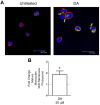Dopamine Increases CD14+CD16+ Monocyte Transmigration across the Blood Brain Barrier: Implications for Substance Abuse and HIV Neuropathogenesis
- PMID: 28133717
- PMCID: PMC5406247
- DOI: 10.1007/s11481-017-9726-9
Dopamine Increases CD14+CD16+ Monocyte Transmigration across the Blood Brain Barrier: Implications for Substance Abuse and HIV Neuropathogenesis
Abstract
In human immunodeficiency virus-1 (HIV) infected individuals, substance abuse may accelerate the development and/or increase the severity of HIV associated neurocognitive disorders (HAND). It is proposed that CD14+CD16+ monocytes mediate HIV entry into the central nervous system (CNS) and that uninfected and infected CD14+CD16+ monocyte transmigration across the blood brain barrier (BBB) contributes to the establishment and propagation of CNS HIV viral reservoirs and chronic neuroinflammation, important factors in the development of HAND. The effects of substance abuse on the frequency of CD14+CD16+ monocytes in the peripheral circulation and on the entry of these cells into the CNS during HIV neuropathogenesis are not known. PBMC from HIV infected individuals were analyzed by flow cytometry and we demonstrate that the frequency of peripheral blood CD14+CD16+ monocytes in HIV infected substance abusers is increased when compared to those without active substance use. Since drug use elevates extracellular dopamine concentrations in the CNS, we examined the effects of dopamine on CD14+CD16+ monocyte transmigration across our in vitro model of the human BBB. The transmigration of this monocyte subpopulation is increased by dopamine and the dopamine receptor agonist, SKF 38393, implicating D1-like dopamine receptors in the increase in transmigration elicited by this neurotransmitter. Thus, elevated extracellular CNS dopamine may be a novel common mechanism by which active substance use increases uninfected and HIV infected CD14+CD16+ monocyte transmigration across the BBB. The influx of these cells into the CNS may increase viral seeding and neuroinflammation, contributing to the development of HIV associated neurocognitive impairments.
Keywords: CD14+CD16+ monocytes; CNS HIV reservoirs; Dopamine; HAND; Neuroinflammation; Substance abuse.
Conflict of interest statement
Figures








Similar articles
-
Dopamine increases CD14+CD16+ monocyte migration and adhesion in the context of substance abuse and HIV neuropathogenesis.PLoS One. 2015 Feb 3;10(2):e0117450. doi: 10.1371/journal.pone.0117450. eCollection 2015. PLoS One. 2015. PMID: 25647501 Free PMC article.
-
Mechanisms of HIV entry into the CNS: increased sensitivity of HIV infected CD14+CD16+ monocytes to CCL2 and key roles of CCR2, JAM-A, and ALCAM in diapedesis.PLoS One. 2013 Jul 26;8(7):e69270. doi: 10.1371/journal.pone.0069270. Print 2013. PLoS One. 2013. PMID: 23922698 Free PMC article.
-
Mechanisms of CNS Viral Seeding by HIV+ CD14+ CD16+ Monocytes: Establishment and Reseeding of Viral Reservoirs Contributing to HIV-Associated Neurocognitive Disorders.mBio. 2017 Oct 24;8(5):e01280-17. doi: 10.1128/mBio.01280-17. mBio. 2017. PMID: 29066542 Free PMC article.
-
Monocytes mediate HIV neuropathogenesis: mechanisms that contribute to HIV associated neurocognitive disorders.Curr HIV Res. 2014;12(2):85-96. doi: 10.2174/1570162x12666140526114526. Curr HIV Res. 2014. PMID: 24862333 Free PMC article. Review.
-
The impact of substance abuse on HIV-mediated neuropathogenesis in the current ART era.Brain Res. 2019 Dec 1;1724:146426. doi: 10.1016/j.brainres.2019.146426. Epub 2019 Aug 29. Brain Res. 2019. PMID: 31473221 Free PMC article. Review.
Cited by
-
A "Drug-Dependent" Immune System Can Compromise Protection against Infection: The Relationships between Psychostimulants and HIV.Viruses. 2021 Apr 21;13(5):722. doi: 10.3390/v13050722. Viruses. 2021. PMID: 33919273 Free PMC article. Review.
-
Cognitive Health in Persons With Human Immunodeficiency Virus: The Impact of Early Treatment, Comorbidities, and Aging.J Infect Dis. 2023 Mar 17;227(Suppl 1):S38-S47. doi: 10.1093/infdis/jiac388. J Infect Dis. 2023. PMID: 36930639 Free PMC article. No abstract available.
-
Dopamine: an immune transmitter.Neural Regen Res. 2020 Dec;15(12):2173-2185. doi: 10.4103/1673-5374.284976. Neural Regen Res. 2020. PMID: 32594028 Free PMC article. Review.
-
Specimen Collection for Translational Studies in Hidradenitis Suppurativa.Sci Rep. 2019 Aug 21;9(1):12207. doi: 10.1038/s41598-019-48226-w. Sci Rep. 2019. PMID: 31434914 Free PMC article.
-
Where Is Dopamine and how do Immune Cells See it?: Dopamine-Mediated Immune Cell Function in Health and Disease.J Neuroimmune Pharmacol. 2020 Mar;15(1):114-164. doi: 10.1007/s11481-019-09851-4. Epub 2019 May 11. J Neuroimmune Pharmacol. 2020. PMID: 31077015 Free PMC article. Review.
References
-
- Abbott NJ, Ronnback L, Hansson E. Astrocyte-endothelial interactions at the blood-brain barrier. Nat Rev Neurosci. 2006;7:41–53. - PubMed
-
- Althoff K, Reddy P, Voltz N, Rose-John S, Mullberg J. Shedding of interleukin-6 receptor and tumor necrosis factor alpha. Contribution of the stalk sequence to the cleavage pattern of transmembrane proteins. Eur J Biochem. 2000;267:2624–2631. - PubMed
-
- Anthony IC, Crawford DH, Bell JE. B lymphocytes in the normal brain: contrasts with HIV-associated lymphoid infiltrates and lymphomas. Brain. 2003;126:1058–1067. - PubMed
Publication types
MeSH terms
Substances
Grants and funding
- R01 MH090958/MH/NIMH NIH HHS/United States
- P30 AI051519/AI/NIAID NIH HHS/United States
- U01 AI035004/AI/NIAID NIH HHS/United States
- U01 MH083501/MH/NIMH NIH HHS/United States
- R01 MH075679/MH/NIMH NIH HHS/United States
- U24 MH100931/MH/NIMH NIH HHS/United States
- T32 AI070117/AI/NIAID NIH HHS/United States
- K99 DA044838/DA/NIDA NIH HHS/United States
- R25 MH080663/MH/NIMH NIH HHS/United States
- R01 DA039005/DA/NIDA NIH HHS/United States
- P30 AI124414/AI/NIAID NIH HHS/United States
- R01 DA025567/DA/NIDA NIH HHS/United States
- R01 MH096625/MH/NIMH NIH HHS/United States
- K01 DA029476/DA/NIDA NIH HHS/United States
LinkOut - more resources
Full Text Sources
Other Literature Sources
Medical
Research Materials

